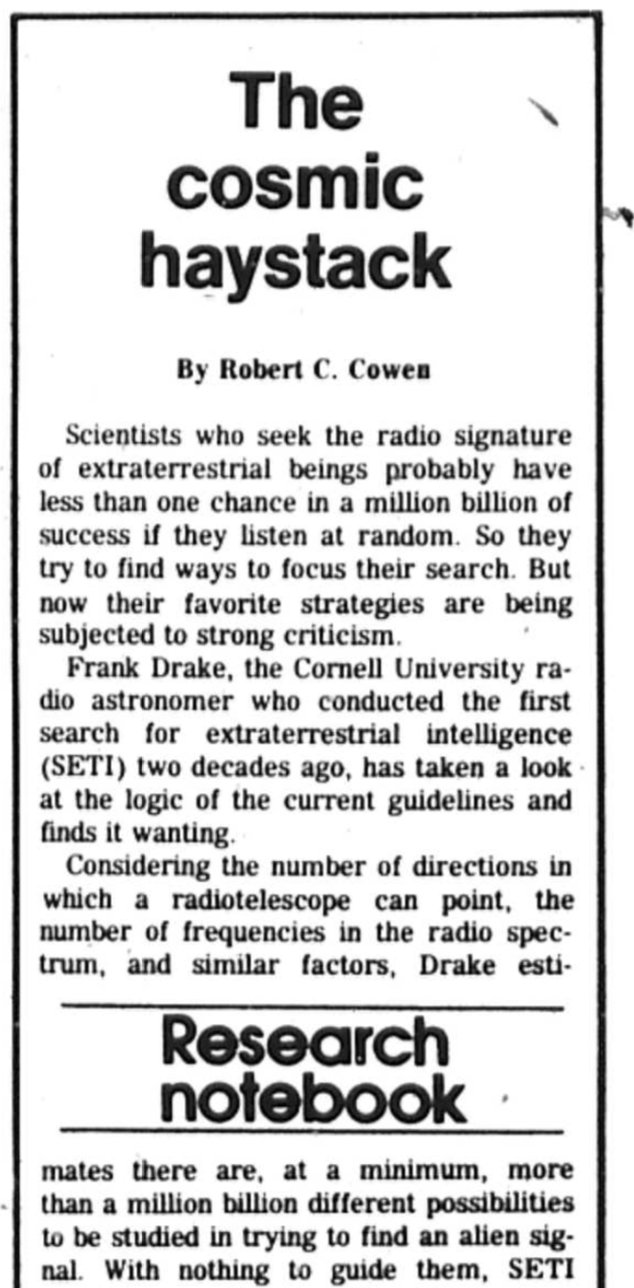Early when I was learning about SETI I was reading about “magic frequencies” and the “Water Hole.”
Back in the early days of radio SETI, instrumental bandwidths were pretty narrow, so Frank Drake and others had to guess what frequencies to observe at to find deliberate signals. One wants a high frequency to avoid interference from the Earth’s ionosphere and background noise from the Galaxy. But one also wants to observe at a high frequency to avoid lots of emission from Earth’s atmosphere. There is a “sweet spot” between these problems, in the range of 1–10 GHz:
In this broad minimum are two famous and strong astrophysical emission lines: the spin-flip hyperfine transition due to hydrogen (the “21 cm line”), and the emission from the hydroxyl radical (OH-). Since these two species combine to form water, and since water is essential to life-as-we-know-it, the region between these two lines is known as the “water hole”. This has a nice pun to it too as a reference to a place where savannah animals (or barflies) gather. As Barney Oliver put it “Where should we meet? The watering hole!”
Trying to determine exactly which frequency in the Water Hole to search became a game of guessing “magic frequencies” (I think the term is due to Jill Tarter, though I could be wrong) to tune one’s telescope to.
When I was learning about all of this, I was reading the Wikipedia article on the Water Hole and I saw this intriguing link:

Clicking on that last link sent me down a nifty rabbit hole and eventually got Schelling points introduced into the SETI literature.
I wrote a while back on Schelling points and their relevance to SETI. Go there for the full story, but briefly: Thomas Schelling was an economist and game theorist who considered games where players must cooperate (everyone wins or everyone loses) but cannot communicate. His example was finding someone else who is also looking for you in New York City. The prospects for winning such a game seems hopeless, but Schelling’s insight was that it was actually pretty easy if you could correctly guess the other person’s strategy, since some strategies are clearly bad (a random search) and others are plausibly good (go to a major landmark).
These optimal strategies are characterized by what we now call Schelling points: in New York City, it’s the Empire State Building and noon are good ones.
Amazingly, ABC News Primetime got people to actually play that game and they won! In hours!
When introducing this idea to the world in his book The Strategy of Conflict, Schelling wrote:
[A good example] is meeting on the same radio frequency with whoever may be signaling us from outer space. “At what frequency shall we look? A long spectrum search for a weak signal of unknown frequency is difficult. But, just in the most favored radio region there lies a unique, objective standard of frequency, which must be known to every observer in the universe: the outstanding radio emission line at 1420 megacycles of neutral hydrogen” (Giuseppe Cocconi and Philip Morrison, Nature, Sep. 19, 1959, pp. 844-846). The reasoning is amplified by John Lear: “Any astronomer on earth would say ‘Why, 1420 megacycles of course! That’s the characteristic radio emission line of neutral hydrogen. Hydrogen being the most plentiful element beyond the earth, our neighbors would expect it to be looked for even by tyros in astronomy’” (“The Search for Intelligent Life on Other Planets,” Saturday Review, Jan. 2, 1960, pp. 39-43). What signal to look for? Cocconi and Morrison suggest a sequence of small prime numbers of pulses, or simple arithmetic sums.
So the water hole is a Schelling point! Or it could be—we need to guess the mind of ET and ask: what frequencies would they guess we would guess, and perhaps water and ionospheres and radio just aren’t their thing? Schelling’s players can win the game only because they have a common cultural heritage and know about the Empire State Building being famous. If we played that game with aliens, we’d probably lose.
So what do we know we have in common with aliens? Max Planck had an idea.

Max Planck
Max Planck is one of the most important figures in modern physics, famous for many key insights but among them his constant, h, and his eponymous “natural units.” Planck realized that there is a fundamental length scale of the universe, set by the nature of space and time, gravity, and quantum mechanics. We call it the “Planck length” and it is given by:

Very roughly and heuristically, it is the wavelength of a photon so energetic that its wavelength is equal to its Schwartzchild radius (that is, a photon so dense with energy that it would be a black hole). Today, we recognize this as the scale on which quantum mechanics and General Relativity give different answers or become mutually incompatible. Dividing by the speed of light, one defines a fundamental timescale of the universe, which could be interpreted as an observing frequency.
In his famous paper on the topic written in 1900, he wrote:
It is interesting to note that with the help of the [above constants] it is possible to introduce units…which…remain meaningful for all times and also for extraterrestrial and non-human cultures, and therefore can be understood as ’natural units’
and that
…these units keep their values as long as the laws of gravitation, the speed of light in vacuum, and the two laws of thermodynamics hold; therefore they must, when measured by other intelligences with different methods, always yield the same.
So he imagined that these units would be known to extraterrestrial physicists, unlike, say, kilograms and seconds which are completely arbitrary and anthropocentric. Since what we’re looking for is a frequency that we know they would know that we know, this seems like a good Schelling point!
The problem is that the Planck time is way way too short—photons at those frequencies are little black holes (or something—we don’t have physics for it) so don’t exist (or can’t be produced, anyway.) So how could we use them?
Well, there is another fundamental physics constant, another fundamental unit in nature, which is the fundamental unit of charge. Aliens would have to know that! Combining the charge of the electron with the speed of light and Planck’s constant h one gets the fine structure constant:

which has a value near 1/137 and is dimensionless. This is a constant of nature that we do not have a way to calculate purely mathematically or from first principles—it measures the degree to which electrons “couple” to photons, and so governs how all of electromagnetism and light works.
So, can we get another frequency if we multiply the inverse of the Planck time by the fine structure constant. That frequency turns out to still be too high to observe, but there’s no reason we couldn’t keep multiplying by the fine structure constant until we get a useful frequency. This process would actually generate a large number of frequencies—a frequency “comb” with many “teeth.” Some of the frequencies generated this way are at interesting frequencies: 610.3 nm in the optical, and 26.16 GHz in the microwave, for instance, are both easily observed from Earth and in fact the sorts of frequencies we might use for communication. These are Planck’s Schelling points!
But there are some caveats here. Are Planck’s units really that universal? Look at those equations above: they both have a factor of 2π in them. Where did that come from?
Well, Planck liked to define things in terms of angular frequency, meaning the time it takes the phase of an oscillator to change by 1 radian. The 2π goes away if you choose to define frequency in terms of cycles per unit time (as astronomers do for light or engineers do for AC electricity). It’s arbitrary! So, we could also define both constants without the 2π. Maybe aliens like it better that way? So we can build a frequency comb that way, and that’s another potential Schelling point.
Also, maybe we’re overcomplicating things. If we’re going to choose a base to raise to a power then maybe the fine structure constant isn’t the natural one to use—any mathematician will tell you that the natural base to use is the base of the natural logarithm, e! (Different e from the one above, though). Then you can do it all with only 3 physical constants instead of 4, so maybe more obvious? So that’s another potential Schelling point.
Or maybe you want to make sure the frequencies have physical meaning akin to the 21 cm line Shelling mentioned, and as long as you’re thinking about light you might like to use the mass of the electron instead of the gravitational constant G. In that case you could define your base unit of energy as half of its rest energy of the electron and use the fine structure constant to make your comb. Seems a bit arbitrary, at first, but the energies defined by that comb are

and when n=2 we have an important unit in physics, the Rydberg, related to the energy it takes to ionize hydrogen (in reality there’s a small correction factor because protons are not infinitely massive, but this is the fundamental unit). This unit was known even to classical physics and so is a very “natural” way to define a universal energy or frequency. So there’s yet another frequency comb.
We could surely define more. The truth is, Planck’s insight isn’t all that helpful for guessing exactly which frequencies we should look at because we still need to make lots of choices and we don’t have any guide beyond what seems natural.
But still, it’s a useful illustrations of both the power and limitations of Schelling’s idea. Also, we can add the frequencies that appear in these frequency combs to the lists of “magic frequencies” we check for—more ideas about places to look can’t hurt, because today modern radio observatories can search billions of frequencies at once, so it costs nothing to check a few more more that they observed.
But there may be another insight here: these frequency combs generate multiple frequencies, and perhaps we should look for signals at all of them. After all, unlike looking for someone in New York, there is little preventing us from looking in more than one channel at once, or from their signals being at more than one frequency at once. Perhaps we should be looking for combs of signals, or at multiple wavelengths simultaneously!
Anyway, this idea of Schelling points has gained a lot of traction since I made passing reference to it in a review article a while back, but it has no proper, refereed citation in a SETI context (beyond Schelling’s offhand remark in his book). So I’ve written up the idea formally, including the Planck Frequency Comb as a case study, in a new paper for the International Journal of Astrobiology. You can read it on the arXiv here.
Thanks to Sabine Hossenfelder and Michael Hippke for these translations of Planck’s 1900 paper.

















 140.27: Mark Giovinazzi of Penn presents his work with Cullen Blake on the characterization and operation of the gigantic NEID CCDs.
140.27: Mark Giovinazzi of Penn presents his work with Cullen Blake on the characterization and operation of the gigantic NEID CCDs.







